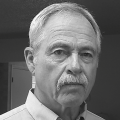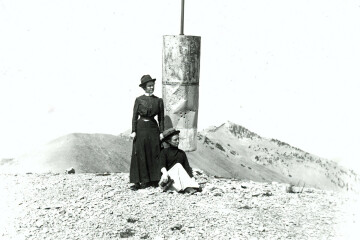The Bridger Foothills Fire One Year Later
Steve McGann, photos by Angie Ripple

On the afternoon of September 4th, 2020 I was on a bike ride south of Bozeman. Turning north I gazed up at the Bridgers as always. There was a puff of smoke above the M. Intrigued, I rode to town keeping an eye on the smoke. Back home I checked the news and found that a fire had started just above the Foothills trail and was estimated to be at 80 acres. The smoke was visible from town but it seemed to be a slow-moving fire. That was Friday.
Fire season had begun late in Montana but by September it had been dry for almost six weeks. Saturday morning the condition of the fire was not much different, it looked as if it was gradually working its way up to the ridge. We drove down Gallatin Canyon for a hike and were shocked by the scene over the Bridgers as we later exited the canyon. The smoke cloud was thousands of feet high and enveloped the entire south end of the range. At the base of the cloud was the orange glow that means flames. In a matter of three or four hours, the fire had grown from less than two hundred acres to thousands. High winds had driven the flames up to the ridge and then spun it around to the east onto a steep and rocky face. From there it roared north and downslope into the forest and consumed houses, sheds, and barns along with the trees. It jumped the highway and started up Jackson Creek. Kelly Canyon was threatened.
The wind subsided but the fire burned for days and was not completely contained for a couple of weeks. It covered over 7000 acres. No one was lost though some firefighters were injured. Almost thirty homes were burned and many other buildings.
Living for decades in the west we have become familiar with wildfires and fire season. We have witnessed those giant plumes of smoke rising tens of thousands of feet into the sky. In 1988 fire burned half of Yellowstone Park. Most of that has regrown and some has burned again. Yet this Bridger fire burned an area of our home mountains that we hike almost daily. In an area where I recognize certain trees, rocks and outcrops, I was anxious to see the damage and find out how extensive and severe it was.
The first time I hiked the M Trail after it reopened it felt like I was going to visit a friend who had recovered from a serious illness. I was nervous about what I would find. The good news was that none of the area and none of the trails up to the M had burned at all. The fire had begun north and up from the M itself and then moved southeast before it raged over the ridge and down the other side. But a few hundred yards up from the M area I began to smell the charred trees. There is a sloped meadow there that contains a distinctive fir tree I had always admired. It was unharmed. Almost immediately upslope the fire made a distinct boundary. It had burned hard and hot there. Words like scorched or moonscape or wasteland seem trite, inadequate. My impression was of an artist creating a painting of a forest landscape and then suddenly splashing black paint diagonally across the canvas. Where there had been a full, if not thick, stand of woods there was nothing but burnt sticks and drifts of ash. Even the trail, which had been worn into the rock and roots for decades, was gone, indistinguishable in the soot piles.
The trail the rest of the way up to the ridge was similar. Landmarks I had passed for years; trees and even stones were simply gone. Yet fire, especially when wind-driven as this one had been, is fickle. In the middle of an area entirely devastated one tree will stand undamaged. At one spot a large boulder that I had noticed for years, seemed to have exploded into fragments from the heat. Yet thirty feet away a little grove of junipers was still green and alive. I followed the ridge trail to Baldy Peak summit. The area where the fire had gone over the ridge to the east side was completely burned over. After that most of the major damage was down on the benches near the Bridger Canyon entrance. But the flames had climbed back to the crest of the ridge and back over to the west side in a number of spots, so the trail at the top wound in and out of burned ground. By the base of Baldy, all the damage was down to the east. There were places where houses and outbuildings had been that looked like bomb craters. Other homes nearby had been saved, I am sure by great effort from the firefighters and homeowners.
At some point when the fire was still raging there was talk of danger to Bridger Bowl. I was skeptical of that possibility, it seemed to be too far north. But from up on the ridge looking down on the scene, I was amazed at how far it had reached. Another day of high wind would definitely have spelled disaster for many more thousands of acres and possibly the ski lodges.
As hikers and lovers of an area that has been burned, we know we cannot control the nature involved. We are grateful to those who have battled the flames. Yet in our loss, we need a scapegoat. Rumors of cause of the Bridger Foothills Fire, as it came to be known, were varied. (If there is a fire in your area, hope it does not acquire a name. That means it is substantial.) The hiker rumor had it that someone who was not even a hiker wandered up and tossed a Marlboro. Those who were not hikers blamed a hippie throwing out a joint. The most imaginative one involved a person who hated the M or possibly all hillside letters. In the end, it turned out to have been a smoldering lightning strike that could have lain dormant for weeks. This explanation was rather unsatisfying in that there was, in fact, no one to blame. This was all too random but there was a much larger issue. Losing a trail is not like losing a home.
Within a couple of months of the fire we had left Bozeman for the winter. The process of shock and then grief at the loss of the beauty of the ridge trail was not complete for me. After a few hikes up into the burn, I had avoided going there. I stuck to the trail to the M or the Foothills trail which were unharmed and reassuring. But with the spring I decided to continue the process. I was interested to see what effect the winter snows had, surely at first that would not be good, probably channels of erosion to mar the already ruined ground. Then perhaps some grass, even flowers, maybe fireweed.
My first Bridger hike of 2021 was in early May. At the edge of the burn there is a Forest Service sign urging caution. The sign seems unnecessary, the boundary is so stark. It was a very windy day, a storm to the north deciding whether to flow over the ridge or to slide my way down the west slope. I thought about the ruined trees toppling over in the wind and soon saw some that had done so during the winter. The trail though was unblocked. As hoped, the black landscape was dotted with green. The ground was not a carpet of growth but at least encouragingly patchy with grass, yellow arrowleaf blossoms and a few larkspurs. The few trees that had survived looked okay. A couple of junipers sheltered by a little rise, one fir, singed yet alive in the midst of blackened snags. The trees after all cannot run away, they have to stand there and take it. For a very few their spot was a good one.
The trail felt funny. I had walked across the rocks and soil hundreds of time but more than once I found myself wandering off. The green edges that had kept hikers funneled to the track were simply gone. It was easy to stray. Landmarks were missing. It was still hard to accept the devastating change but the shock was gone. Hopefully, we will see the return of more undergrowth and maybe birds as the year progresses.
Farther up the trail, just before the final steep hill to the ridge, there was a structure everyone called the tepee. It was about eight feet in diameter and twelve high made of deadfall. Occasionally someone would tear it down, but it would soon be rebuilt. It was a large version of the perfect design for a campfire. And dead and dry. There was nothing left, not sticks or burnt ends, not even ash. Nothing but a rock that was enclosed by it and had crumbled as if in a forge, its shards the only evidence remaining. It is hard to imagine the scene when this burned. Impossible to imagine the heat.
I wanted to see if I could locate the ignition point. Maybe to make the whole thing official, at least in my mind. I somehow thought it would be easy, a small point fanning out into the conflagration. Two weeks following my first hike up into the fire zone I walked there again. This time I turned north on a spur trail above the M and traversed until I reached the burn. After fifteen minutes hiking on the edge, I found myself on a rubbly cliff that overlooked a gully. I angled down to the bottom. The little canyon was just four feet wide at the base and sloped steeply up both sides in a symmetrical V. Trees were still standing but blackened. Everything else was burned. The V narrowed and there was a line, a distinct sharp boundary. On one side thick green brush and tall living trees. On the other ash. It was even more unreal than the fantasy point I had envisioned. As if there was a wall and someone had poked a cannon through it and blasted the fire up into the canyon.
To the south, the cliff I had scrambled down had corralled the flames, at least until the canyon eased into meadow and forest slopes. This may have saved the M area. To the north, the angle eased faster and there were burned areas nearly as far downslope as the V. When I explored these they seemed afterthoughts as if the fire had gotten there and then lost interest. For a clueless amateur the V gully was the spot.
I had come in the easy way from the top. I knew that eventually on the way out through the bottom of the gully I would cut across the Foothills Trail. The undergrowth was thick, the bushwhacking fierce. Just a few hundred yards took close to twenty minutes. That eliminated the idea of a human cause. No one would have bothered to crash through that mess.
One year later much of the burn area remains stark. We have been spared any large local fires though smaller ones have occurred and been extinguished by brave and skillful firefighters. This year’s challenge so far is smoke from the wildfires other communities are suffering. Fire, flood, drought, Covid. My personal woes of a lost trail melt away in my sympathy for so many others that have gone through so much worse.
The mountain will always be there. Its changes are all small, subtle, if sure. Hard to view, easy to miss, except for fire. And for ice.


